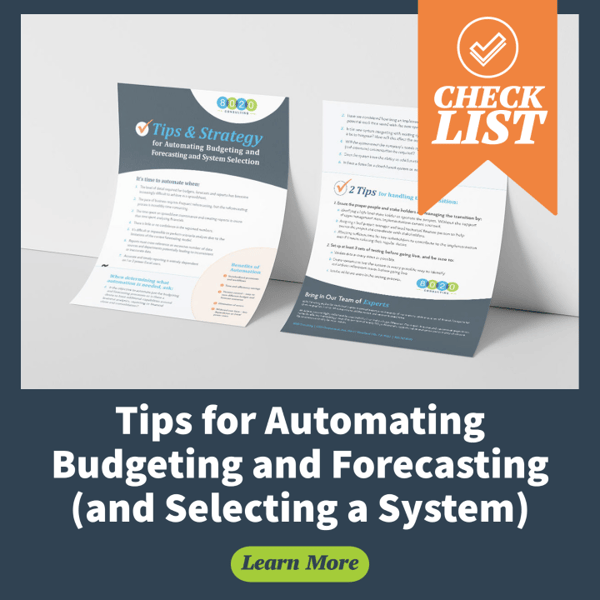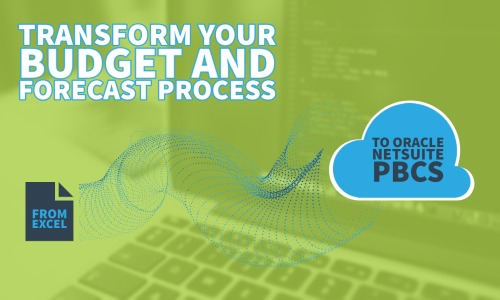For small to mid-size companies, relying on Excel can create stress every budget season, including a forecast cycle or two, if time permits! Excel is a great tool for analysis and data representation. However, the pain of consolidating, linking and maintaining version control with multiple spreadsheets and several users to create an annual budget takes up valuable time and resources. The finance team should be spending time on actual analysis, reviewing information and telling the story of the company’s financials. Let’s review how moving from Excel to a platform like Oracle NetSuite PBCS (Planning & Budgeting Cloud Service) can help.
Consider an Enterprise Performance Management Solution
Are you and your team drowning in Excel files during budget season? Is the business changing rapidly, making it more difficult for your team to maintain static templates? Are static Excel templates emailed to budget owners and returned via email to your team for consolidation? This situation is an all-too-familiar scenario for many finance groups. And to add fuel to the fire, emails go missing, or multiple versions are re-sent to your team.
An Enterprise Performance Management (EPM) solution facilitates a budget process more efficiently. Utilizing an EPM system provides a central repository of financial data that can be sliced and diced using an Excel add-in, which is a familiar tool used for financial analysis. Many of the EPM solutions have reporting and dashboarding capabilities for senior leadership to digest financial information quickly. Budgets can be entered and reviewed by P&L owners, and there can be an approval workflow and audit trail of changes.
Having experienced implementing an EPM solution, specifically Oracle NetSuite PBCS, switching from Excel to an EPM tool brought the following benefits to the budget process:
- Transparency
- Manageability
- Collaboration
- Data Integrity
Learn more about identifying whether you need an automated system for budgeting and forecasting:

Finding the Right Solution, and Selecting Oracle NetSuite PBCS
The selection process of an EPM solution can be overwhelming. Factors to consider include, but are not limited to, the speed to implement, integrations and application features. To speed up implementations, a cloud-based option is the path businesses often choose. Another consideration involves the integration of data between your ERP and EPM tool, specifically how data will be loaded. Each tool has unique features and specifications. During the RFP and demonstration process, the solutions considered were Workday Adaptive Insights, Host Analytics and Oracle NetSuite PBCS. Though there are many Oracle Planning and Budgeting Cloud benefits, with NetSuite as the company’s Enterprise Resource Planning (ERP) system, implementing PBCS was the most obvious option for four main reasons:
- Compatibility within the same Oracle ecosystem meant there would be a seamless connection to and from NetSuite and PBCS.
- A drill through feature from PBCS to NetSuite allowed users to access transactional data.
- PBCS utilizes the popular Excel add-in, Smart View, which all other vendors were comparing themselves against.
- PBCS was robust and could scale with our rapid growth, both organically and through acquisition.
Learn more about the process of system selection in our guide to selecting a system for ASC 606. It offers transferrable principles and processes: “Selecting a Revenue Management System for ASC 606” [Whitepaper]
Design for the Future
After an EPM solution is selected and requirements are gathered, the design phase of the project begins. During the design sessions, it usually becomes clear that current budget processes and finance views will not work in a future-state solution. For example, a finance process improvement and redesign process may include the requirements for how workforce would be budgeted, how volumes and rates would be captured (which may not be readily available by product) and structuring the organization for proper workflow approvals.
To meet the requirements within PBCS, the Workforce cube can be utilized to manage existing and new employees, and a Revenue cube can be developed to capture volume and rates—along with the enablement of the Financials cube for a consolidated view of all financial data. You can also take advantage of PBCS Valid Intersections functionality, where foreign entities can budget in their home currency with no concerns of inputting data to invalid currencies. Finally, PBCS can perform allocations where applicable, such as Cost of Goods Sold.
Training, Testing & Roll Out of Oracle NetSuite PBCS
Before go-live of PBCS, routine meetings with internal stakeholders and sponsors can help mitigate risks and surprises and ensure requirements are being met. Training for users is often completed before, during and after User Acceptance Testing (UAT). During the UAT phase, bugs will be identified and fixed by your implementation partner. Input and review forms are also modified during UAT to help increase performance, when applicable. Once the model successfully passes UAT, the solution is rolled out to all end users.
An important consideration, and a cost not usually considered, is a resource to administer PBCS. If the current finance team does not have the bandwidth and/or skillset, a systems administrator is strongly recommended. The administrator will be responsible for updates and maintenance, running business rules, documentation, and security controls.
The phases of implementation for an EPM solution take time from the day-to-day operations of the finance team. For future Oracle NetSuite PBCS implementations, keep 8020 Consulting in mind and we can guide you through the selection, design, and implementation process. If you have questions or would like to connect, take the first step by contacting us, or visit our financial systems consulting services page to learn more:




